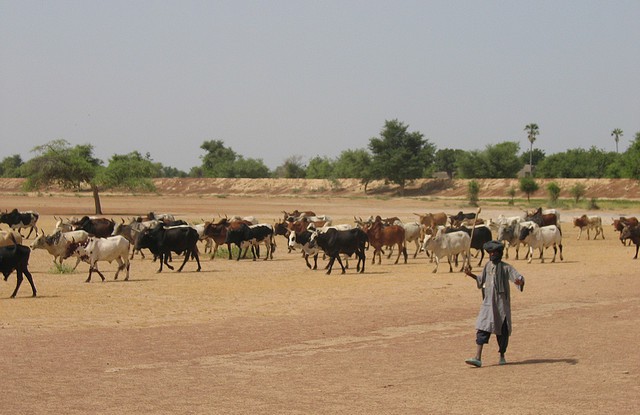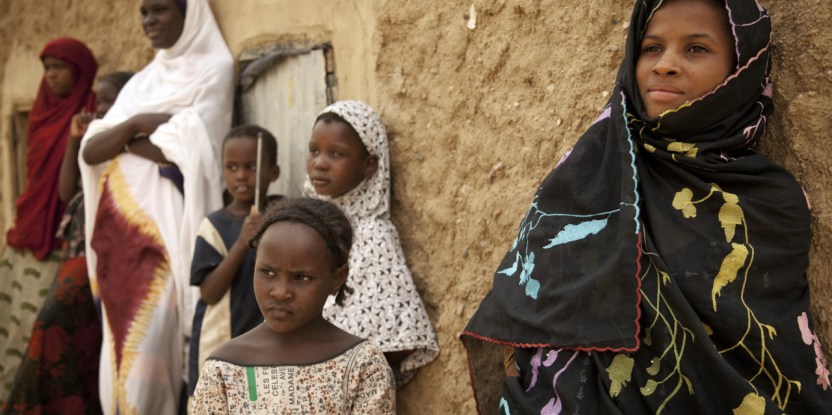
BOGOR, Indonesia—For generations, Malian farmers have traveled north and south with their cattle and sheep, following grass and water, and meeting traders in market towns to sell some of their animals.
This seasonal migration is a way to cope with unpredictable rains but is becoming more complex, however, as expanding permanent farms occupy land previously used for grazing. In response, people in Mali’s livestock industry are becoming more sophisticated, taking advantage of expanding mobile phone, road and banking networks to fine-tune their work to meet the demand of meat consumers in neighboring countries’ coastal cities.
Scientists who interviewed about 200 farmers, middlemen and traders in central Mali in 2008 and 2009 argue in a new publication that markets are more than just a contextual factor in a given population’s vulnerability. Instead, the changes they observed demonstrate that people use trade as a medium to adapt their way of life in the face of climate change and other forms of stress.
“Our article shows that the market is not only a place where you go to dispose of your cull animals and use the local savings and loans group,” said Denis Gautier, a West Africa researcher at the Center for International Forestry Research (CIFOR) and CIRAD, and the lead author of the paper. “It is a place of social construction, which offers farmers and the more proactive traders an alternative to traditional transhumance,” he said, using the term for the practice of migratory livestock raising. Seasonal meetings of buyers and sellers of livestock along north-south routes are increasingly complemented by more modern farming and marketing techniques, the researchers observed.
Our message is not that markets are good or bad, but that their actors are not merely subjected to them
Traders displayed a growing ability to combine individual financial resources and knowledge of the demand in affluent meat-consuming centers in Senegal and Ivory Coast with collective assets, such as the increasing number of loading docks where cattle can easily be loaded on to trucks.
Meanwhile, 28 percent of farmers surveyed said they were prepared to invest in feeding systems and sell fewer, better-quality animals at a higher price if current market trends continued.
“We wanted to show that market changes are not necessarily negative,” said Bruno Locatelli, also a CIFOR and CIRAD researcher and co-author of the paper. “They offer opportunities, which farmers may seize to adapt, including through long-term changes in their production methods.”
MAKING MARKETS
The literature review conducted by the authors of the study shows that scientists usually regard market conditions as an external factor to which people are exposed for better or worse—often in an ideologically charged way. While advocates of capitalism tend to consider good connections to markets as an advantage, opponents assume that proximity to markets and their fluctuations poses a risk.
“Our message is not that markets are good or bad, but that their actors are not merely subjected to them,” Locatelli said. “They take part in the construction of market access—sometimes of entire industries—and this forms part of their adaptation strategies.”
He added that a fresh approach to markets was needed at a time when research increasingly focused on situations of “multiple exposures,” in which communities face climate change at the same time as other forms of stress. Such additional pressure, including fluctuations in the trade of key commodities, can exacerbate the effects of climate change.
“In this case, farmers faced three types of stress: droughts connected with climate change; a change in land use with more arable farming and less pasture available; and changes in market conditions,” Locatelli said.
A NEW LOOK
Such research could transform the way policymakers look at markets when trying to boost people’s ability to adapt to climate change. Development specialists usually look at markets from the outside and seek to help communities generate livelihoods from them—for example, by helping them organize in cooperatives, etc.
The authors of the study suggest that focusing on the infrastructure that helps markets function might be a better way forward.
“There are many industries that perform better when the state does not get involved,” said Gautier, warning that the fragile trade patterns that benefit less empowered people in society can easily be damaged by a formalization of the market rules to the profit of more powerful stakeholders.
He gave the example of women who made a living out of collecting and selling tree leaves in Niger, until a forest management project sought to formalize that trade—resulting in the transfer of the industry’s control to men and forest service agents.
“If you regard markets as socially co-constructed, the actors and their practices can be supported by multiplying bank branches and loading docks but not by interfering in their negotiations or the way they choose their intermediaries,” Gautier said.
Locatelli also cautioned that market-based policies should ensure nobody is left behind.
“In adaptation strategies that support market functions, you should remember that some people will seize new opportunities and others will not.”
For more information about the topics of this research, please contact Bruno Locatelli at b.locatelli@cgiar.org or Denis Gautier at d.gautier@cgiar.org.
CIFOR’s research on climate change forms part of the CGIAR Research Program on Forests, Trees and Agroforestry.
We want you to share Forests News content, which is licensed under Creative Commons Attribution-NonCommercial-ShareAlike 4.0 International (CC BY-NC-SA 4.0). This means you are free to redistribute our material for non-commercial purposes. All we ask is that you give Forests News appropriate credit and link to the original Forests News content, indicate if changes were made, and distribute your contributions under the same Creative Commons license. You must notify Forests News if you repost, reprint or reuse our materials by contacting forestsnews@cifor-icraf.org.
